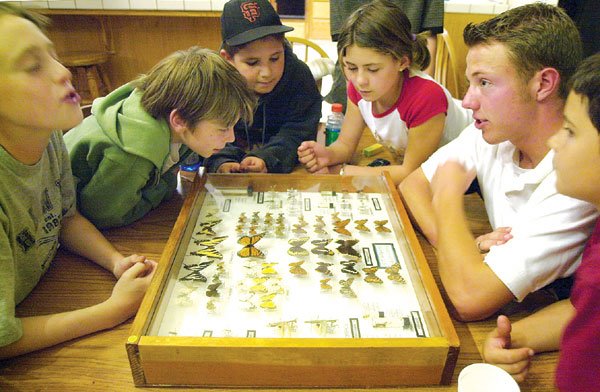GILROY
– Heather McPherson, a San Martin resident, lives many a
10-year-old’s dream. She cares for numerous animals, including
horses, rabbits, dogs, goats and chickens.
GILROY – Heather McPherson, a San Martin resident, lives many a 10-year-old’s dream. She cares for numerous animals, including horses, rabbits, dogs, goats and chickens.
More than a pet owner, Heather is a member of the 4-H Youth Development Program that teaches nearly 300 South County youth valuable citizenship, leadership and life skills. Heather and her fellow 4-H members learn, step by step, how to raise and care for animals, investing their time and money into showing them at county fairs.
Today, 4-H members living both in town and in rural areas are wondering whether their animal care and youth leadership program will be the latest possible casualty of severe county budget cuts.
The outlook right now is grim for 4-H as the county cuts nearly $240 million from its 2004-05 budget. While five other agriculture-related programs are being sliced, 4-H and its hundreds of young local members also may be victims of cuts – and, county officials say, unnecessarily so.
They, along with local 4-H leaders, are fighting for the program that costs a relatively meager $20,000 each year but say their hands are tied.
Kim McPherson, Heather’s mother, is the community leader for her daughter’s San Martin 4-H Club. If the club succumbs to the latest painful round of cuts, her daughter will lose out, she says.
“There isn’t anything out there like 4-H,” McPherson said. “You get the opportunity to have the animals. … You learn how to care for them. It would be very, very sad if 4-H dissolved.”
McPherson said she doesn’t really know where the program stands right now, but from what she’s hearing, it is certainly at risk.
“We have been presented that it’s a financial situation, but there’s too many uncertainties,” she said. “We’re not really sure which way we’re going right now.”
That’s because County Agriculture Commissioner Greg Van Wassenhove and District 1 County Supervisor Don Gage are fighting for 4-H.
Van Wassenhove is making some severe cuts in his department, totaling $422,000, but doesn’t want 4-H to be one of them. The program is one of six that fall under the umbrella of the UC Cooperative Extension and, apparently, must either stay or go as a whole.
“We’re being asked to prioritize, to look at non-mandated discretionary programs, and in my budget … that’s the only discretionary, non-mandated program I have,” Van Wassenhove said. “So, in order for me to meet my budget reduction target, I need to consider the UC Cooperative Extension program.”
Included in the program are Master Gardeners, food and nutrition education for the elderly, county farm advisers and national resources management. The county’s cost for all six programs ia $438,000.
Van Wassenhove figured he could salvage enough of the $20,000 4-H program, the cheapest of the group, with the $16,000 difference. Not so, says the UC Cooperative Extension.
“The UC Cooperative Extension program is a package of individual programs, and 4-H is part of UC Cooperative Extension,” spokeswoman Pam Kan-Rice said. “So, we don’t break off parts of that.”
Kan-Rice did not rule out the possibility of separating 4-H from the others but said it’s never been done before and defeats the larger purpose of the Cooperative, which is to have the programs work together.
“We hope we can save the entire program somehow,” she said. “Because if we close down an office, it would be unlikely that we’d be able to reopen it in the future.”
Van Wassenhove said his hands are tied, and 4-H may be cut if the UC does not change its policy.
“It’s the baby with the bath water,” Van Wassenhove said. “This is not just a county budget problem; we need to have some flexibility from the state university.”
Albert Escobar, community leader for the 55-member Adams 4-H club, wants to see cities and open space groups give the program their support.
“All these groups seem quiet when it actually comes time to stand up and speak out,” he said. “I hope that somewhere along the line, someone comes out and says. ‘We have to put some money into this.’ ”
His three sons learn valuable life lessons through 4-H by raising animals, speaking in front of large groups and volunteering in the community.
“Even if they choose not to go into the ag field, they’ve learned a lot about public speaking, team-building, leadership and other skills,” he said.
McPherson agreed. Heather, a member of her 109-member club’s executive board, learns responsibility and organization. 4-H clubs are run by their members, ages 5 to 19, while parent volunteers help out.
“She’s done animal projects, so she’s learned how to take care of her animals. She’s been involved in the community,” McPherson said. “That’s such a unique aspect, to be able to give and not expect something back in return.”
Van Wassenhove and Gage have been in contact with UC officials to find a solution that will save 4-H. Several suggestions have arisen, but none seem to satisfy any party.
“There’s got to be a way to maintain this program,” said Vicky Bosworth, the president of the Santa Clara County 4-H Club Council. “We’re not saying don’t cut the money – we know that has to happen – we’re saying don’t cut out the program entirely.”
One option, although undesirable, would be to trim all six Cooperative programs down to the nub.
“That’s what we’re talking to (the UC) about – making everything smaller,” Gage said. “They’re trying to pressure us to do it all and not just one. … They’re being very stubborn about it.”
Van Wassenhove said keeping all six UC programs, even at a minimal level, is “not an option” because he would be forced to cut into mandated programs.
Another option, suggested by 4-H, would be to find federal funding to maintain the program without the UC, or the 4-H name. The $20,000 to fund 4-H pays for a part-time secretary and office space rental.
Escobar said the program “wouldn’t be the same thing” if it somehow struck out on its own.
“That would be the last thing that we do, if we couldn’t make anything else work, is we would find the funding and do it on our own,” Gage said. “Most of the 4-H people that I talked to said they were willing to pitch in some dollars … we’re trying to not have that happen.
“We’ll do the best we can as we get additional revenue, but right now it just doesn’t look good.”
“There will also be domino effects: If 4-H stops, the Fairgrounds Management Corporation has said they have no reason to have the county fair,” said Hans Toensfeldt, treasurer for the county 4-H council.
That, he said, would pretty much kill Future Farmers of America, a high school group similar to 4-H, as well as some agriculture, floriculture, and other community groups.
“The county would stand to lose a direct $2.3 million economic impact, plus about another $1 million worth of effort put in by volunteers – primarily in the 4-H and Master Gardeners Programs. I have no idea of the cost of the domino effects.”
Gage, Van Wassenhove and 4-H leaders are meeting in a couple weeks to re-evaluate their options and share information.














